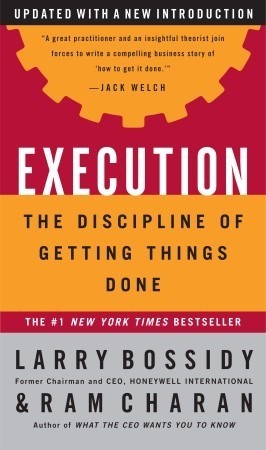More on this book
Community
Kindle Notes & Highlights
Read between
April 28 - June 18, 2020
By the standards of execution, he did almost nothing right.
An execution-savvy leader would have asked that right away.
Then he would have focused on the cause—after
Joe hadn’t picked the right people for the right jobs.
ticket puncher
moved almost every th...
This highlight has been truncated due to consecutive passage length restrictions.
First, he would have involved all the people responsible for the strategic plan’s outcome—including
Second,
Joe would also have asked his people about the hows of execution: how,
Third, Joe would have set milestones for the progress of the plan,
the project would be X percent completed by Y date, and that Z percent of the people would be trained in the process.
new CEO came from manufacturing. He and his team reviewed and discussed the hows with plant managers, set milestones, and followed through with discipline and consistency to review them.
highly respected strategist.
Execution had been a problem
would cut costs and improve efficiency,
sales reorganization would pave the way for the intense focus on providing customers with solutions,
While launching two such enormous initiatives at the same time was an execution error—either
Especially when a business is making major changes, the right people have to be in the critical jobs, and the core processes must be strong enough to ensure that resistance is dissolved and plans get executed.
He failed to confront nonperforming executives or replace them with people able to act as decisively as their counterparts at competitors such as Cisco and Nortel.
but the money was largely wasted because the company didn’t change work processes to take advantage of it.
would not have set such unrealistic goals.
But one part of execution is knowing your own capability.
This is a classic case of the so-called innovator’s dilemma—companies
But the innovator’s dilemma itself has an execution solution
Lucent set out in too many directions at once. It
Brown is deeply execution-oriented,
meetings
exposing them for the first time to the to the details of the company’s plans, critical issues, and finances.
People selection got intense attention.
Brown himself ordered an analysis of the sales staff’s performance and found, among other things, that 20 percent of the salespeople had sold nothing at all for the previous six months.
Brown sharpened the company’s focus on the quality of service it delivered to its clients, which had slipped over the
objective figuring in the performance
re...
This highlight has been truncated due to consecutive passage length restrictions.
The discipline of execution is based on a set of building blocks that every leader must use to design, install, and operate effectively the three core processes rigorously and consistently.
Know your people and your business. Insist on realism. Set clear goals and priorities. Follow through. Reward the doers. Expand people’s capabilities. Know yourself.
Leaders have to live their businesses.
presented by direct reports with their own perceptions, limitations, and agendas, or gathered by staff people with their own perspectives.
aren’t where the action is. They aren’t engaged
This leader is not engaged in his business.
I’ll have an in-depth discussion.
I can sense from the questions and the dialogue how well the manager normally communicates with her workforce.
As a leader, you have to show up. You’ve got to conduct business reviews.
The leader’s personal involvement, understanding, and commitment are necessary to overcome this passive
resistance.
Realism is the heart of execution,
Embracing realism means always taking a realistic view of your company and comparing it with other companies.
Leaders who execute focus on a very few clear priorities that everyone can grasp.
when decision making is decentralized or highly fragmented, as in a matrix organization,
A leader who says “I’ve got ten priorities” doesn’t know what he’s talking about—he
The failure to follow through is


